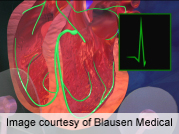Most physicians report being dissatisfied with ECG viewing on prism display of Google Glass
MONDAY, Jan. 19, 2015 (HealthDay News) — Google Glass technology for remote electrocardiogram (ECG) interpretation is significantly less reliable than paper ECG, according to a study published in the Feb. 1 issue of The American Journal of Cardiology.
Omar M. Jeroudi, M.D., from the Veterans Affairs North Texas Health Care System in Dallas, and colleagues examined the accuracy of remote ECG interpretation using Google Glass, an optical head-mounted display device. Interpretations of 10 ECGs with 21 clinically important findings were compared by researchers. The researchers viewed the ECG image at the Google Glass screen, as a photograph of the ECG taken using Google Glass and displayed on a mobile device, as the original paper ECG, and as a high-resolution photograph of the original ECG displayed on a mobile device. Four faculty members and eight fellow cardiologists participated.
The researchers found that the average electrocardiographic interpretation score (one point for identification of each correct finding) was 13.5 ± 1.8 for Google Glass, 16.1 ± 2.6 for Google Glass photograph on a mobile device, 18.3 ± 1.7 for paper ECG, and 18.6 ± 1.5 for high-resolution picture of paper ECG on mobile device. Seventy-five percent of the physicians were dissatisfied with ECG viewing on the prism display of Google Glass.
“In conclusion, further improvements are needed before Google Glass can be reliably used for remote electrocardiographic analysis,” the authors write.
Two authors disclosed financial ties to pharmaceutical and medical technology companies.
Copyright © 2015 HealthDay. All rights reserved.








